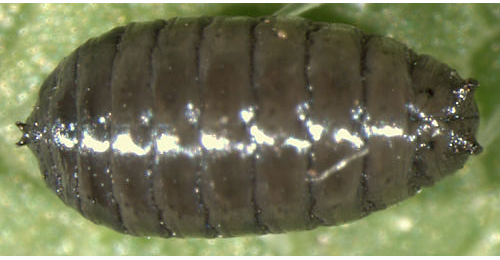|
||||||
|
PEUCEDANUM. Milk-parsley, Hog's Fennel and Masterwort [Apiaceae] |
|
Four species of Peucedanum are recorded in Britain. These include the native Milk-parsley (P. palustre) and Hog's Fennel (P. officinale). Peucedanum ostruthium is treated as Imperatoria ostruthium and Peucedanum palustre is treated as Thyselium palustre by Stace (2010). Four British miners recorded on Peucedanum. A key to the European miners recorded on Peucedanum is provided in Bladmineerders van Europa. |
Key for the identification of the known mines of British |
1a > Leaf-miner: A narrow linear mine which can develop into a secondary blotch (Spencer, 1976: 517). Upper-surface mine in the tip of a leaf segment in primary corridor, but quickly turning into secondary blotch within the limited space of the leaf segment. The mine begins in the very tip of the segment, this initial section later becomes unrecognisable. Frass in fine granules. Pupation outside the mine. |
|
Phytomyza thysselini Hendel, 1923 [Diptera: Agromyzidae]. |
1b > Leaf miner: A regular greenish inter-parenchymal blotch mine, frequently delimited by two veins, appearing somewhat mottled as a result of small deeper areas of feeding through the upper parenchyma (Spencer, 1972b: 78 (fig. 259); Spencer, 1976: 428, 429 (fig. 748). The mine starts with a quite inconspicuous lower-surface corridor that soon changes into an extensive interparenchymatous blotch. The upper cell layer of the palisade parenchyma is eaten away in many places, giving the mine in transparency a perforated appearance. Fresh mines are pale green, later they turn brown; they give the leaves a strikingly diseased impression. Feeding lines absent, frass grains strikingly few. Larvae solitary. Pupation outside the mine, exit slit in lower epidermis. Forms a blotch mine between two veins, having a characteristic sieve-like appearance (where the larva has fed through the upper parenchyma). Pupation outside the mine.. |
 Phytomyza heracleana puparium Image: © Willem Ellis (Bladmineerders van Europa) |
|
Phytomyza heracleana Hering, 1937 [Diptera: Agromyzidae]. |
1c > Leaf-miner: A small regular blotch, which can be enlarged when several larvae feed together (Spencer, 1972b: 105 (fig. 360, putative mine on Pimpinella saxifraga), 466; Spencer, 1976: 465 (fig. 816, mine on Peucedanum oreoselinum). Roundish, upper-surface blotch, about 1 cm in diameter. No trace of a preceding corridor. Frass in coarse grains. Pupation outside the mine; exit slit in upper epidermis. |
|
Phytomyza pauliloewii Hendel, 1920 [Diptera: Agromyzidae]. |
1d > Leaf-miner: The larvae are often gregarious and feed on the underside of the leaf causing a 'windowing' effect as they eat the mesophyll and lower epidermis. This effect can be seen from the top of the leaf as it discolours. Short, small, irregular, sometimes widened corridor. Mostly a number in a leaf, concentrated in the axils of the midrib and the primary side veins. Each larva makes a number of mines. Often the larva protrudes with its rear end out of the mine, causing most frass to be ejected. While moving, at the leaf underside, silken threads are produced, in wich grains of frass may be trapped. Older larvae live free and cause window feeding, often in a group under a light spinning. |
|
Epermenia chaerophyllella (Goeze, 1783) [Lepidoptera: Epermeniidae]. |
| Last updated 06-Jul-2019 Brian Pitkin | ||
